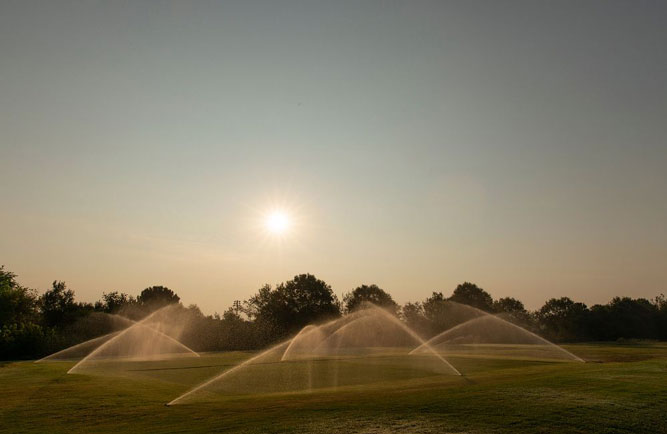Nanobubble research study finds possible improvements to turfgrass systems

Researchers at UGA testing the benefits of using nanobubble-infused irrigation water on turfgrass. (Photo: Andrew Davis Tucker/UGA)
A study, held at the University of Georgia, evaluates the potential applications of nanobubble technology to control pathogens and improve plant growth, water use efficiency and soil biological health in turfgrass systems.
Mussie Habteselassie, a soil microbiology professor, is leading the study. Other researchers on the project include Bochra Bahri, a turfgrass and forage assistant professor and David Jespersen, a crops and soil sciences assistant professor, all at the University of Georgia.
Using technology that generates oxygenated nanobubbles, research will apply nano-charged water to turfgrass root systems through irrigation. Nanobubbles are roughly 2500 times smaller than a grain of salt.
Manufacturers of nanobubble technology say the technology can improve root aeration, increase water use efficiency by changing surface tension and improve soil health by increasing microbial activity.
“This technology is based on the idea of putting oxygen into these tiny, nano-scale bubbles, which have a higher surface area per unit volume and therefore are more stable in liquid than bubbles with larger sizes, such as in carbonated drinks,” Habteselassie said.
Researchers will test the technology through laboratory, greenhouse and field studies to measure how using nanobubble technology influences water use as well as turf shoot and root growth. The study will track changes in activity, abundance and composition of beneficial soil microorganisms that play an important role in organic matter decomposition and nutrient cycling.
“What this potentially means is that, when you irrigate a field with nanobubbles, you increase the oxygen level in the root area of the turfgrass,” Habteselassie said. “More oxygen at the roots means better root development, increased water use efficiency, and also an increase in microbial activity. When you have increased microbial activity, there is better decomposition of organic matter and that releases nutrients and makes them more available to the plant.”
If researchers confirm the benefits of the technology, it could lead to reduced use of pesticides, fertilizers, water and other inputs, reducing the cost to grow sods and maintain turfgrass and decreasing the environmental impact of land use for golf courses.










